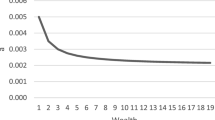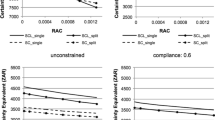Abstract
In a balanced panel data setting, this article proposes an empirical application of the state-contingent (SC) framework for production uncertainty. The SC approach (e.g., Chambers and Quiggin 2000) casts production decisions under uncertainty as the decision to select a portfolio of Arrow-Debreu SC outputs, scheduled to be delivered in the contingent states of nature. Under some stationarity assumptions on the SC decisions (i.e., no technical change, time-invariant states of nature, time-invariant SC portfolio decisions) and regularity assumptions on the data generating process (i.e., cross-sectionally homogeneous state realizations), SC technology can be estimated from balanced panel data that are framed as cross-sectional data of partially-revealed SC portfolio decisions. This allows one to simulate an optimal SC portfolio, determined by the interaction between the estimated SC technology and given risk preferences. In the application to Maryland dairy production data, the stochastic technologies of confinement and intensive-grazing dairy systems are compared. Of the two time intervals (years 2000–2004 and ye0ars 2006–2009) separately analyzed, the optimal production decision has generally become riskier for the confinement system and less risky for the grazing system. These contrasting trends appear directly related to the volatile milk prices, feed cost hikes, and increasing organic milk production during 2006–2009. The risk associated with the optimal portfolio is substantially lower under the SC analysis compared to a typical residual-as-uncertainty approach, suggesting that the typical approach may overstate the risk due to uncertainty.







Similar content being viewed by others
Notes
The properties (1)–(4) represent the standard assumption for ensuring the duality between the input correspondence and the cost function, which makes duality theorems (e.g., McFadden 1978; Färe 1988) directly applicable. Property (5) can be equivalently stated for output set Z(x): μ Z(x) + (1 − μ)Z(x ′) ⊂ Z(μ x + (1 − μ)x ′), ∀μ ∈ (0,1). Properties (3) and (5) together correspond to the convexity of the technology in both inputs and outputs.
While the revenue-cost function is commonly specified with outputs z in stead of revenues r, the notation with r is more succinct here given our assumption of the convexity of C(r; p, w) in r.
Generalized Schur-concavity with respect to π refers to the condition (W s (y)/π s −W t (y)/π t )(y s −y t ) ≤ 0, ∀s,t ∈ Ω where W s (y) ≡ ∂W(y)/∂y s . These preferences can be defined for either known/objective or unknown/subjective probabilities π.
Relative risk premium is a monotonic transformation of absolute risk premium and takes the form (1 − ρ(y; π))−1.
CARA: e(y + λ 1 S; π) = e(y; π) + λ, ∀y ∈ R S, ∀λ ∈ R and CRRA: e(λ y; π) = λe(y; π), ∀y ∈ R S, ∀λ ∈ R ++.
Translation and radial invariance on equal-mean set M(μ) are defined as y, y ′ ∈ M(μ), with \({\boldsymbol{y}} \succ {\boldsymbol{y}}' \Rightarrow e({\boldsymbol{y}} + \delta {{\bf{1}}^S}) \ge e({\boldsymbol{y}}' + \delta {{\bf{1}}^S}),\,\forall \delta \in R\) and e(t y) ≥ e(t y ′),∀t ∈ R + respectively.
For example, invariant expected-utility class coincides with a family of mean-standard deviation (SD) preferences (Quiggin and Chambers 2004).
The convexity of C(r; p, w) in r implies for any r, r ′ ∈ R(C 0), ∀λ ∈ [0,1] C(r; p, w),C(r′; p, w) ≤ C 0 and C(λr + (1 − λ)r′; p, w) ≤ C 0.
Just-Pope technology specification partially relaxes this assumption by allowing the variance to depend on input variable (Just and Pope 1978), capturing a certain inter-dependence between the inputs and the role of uncertainty.
The use of reduced-form specification is not required for the current analysis but is helpful for conserving the degrees of freedom. Also, it helps make the two analyses under the SC and OC frameworks comparable.
Note that this approach allows for the industry-level technology Ψ = ∪ g ∈ \({_{\Bbb G}}\) Ψ g to be non-convex, which may be likely when observed fixed assets x f systematically differ across systems or are disjoint due to distinct assets required for those systems.
Readers interested in empirical tests of asset fixity may be directed to, for example, Chambers and Vasavada (1983).
See also Chambers and Quiggin (2002) for the relationships between the stochastic error structure and the restricted expansion path of a stochastic technology. The authors show that additive and multiplicative stochastic error structures impose constant absolute riskiness (CAR) and constant relative riskiness (CRR) respectively and that the Just-Pope technology specification relaxes these properties and allows for a flexible expansion path.
Following the definition of Machina and Schmeidler (1992), utility W(.) : R Ω → R is probabilistically sophisticated if ∀y, y ′ ∈ R Ω with the same cumulative distribution ∀x, Pr(X ≤ x; y, π) = Pr(X ≤ x; y′, π) ⇒ W(y) = W(y ′). In general, the probabilistic sophistication is not a particularly restrictive assumption.
Strictly speaking, the farm-averages of these variables are used to remove minor variations across production years (e.g., see Table 1).
For example, probability scenarios for 2000–2004 are {0.2, 0.2, 0.2, 0.2, 0.2} in P-1 (equal), {0.2, 0.3, 0.1, 0.1, 0.3} in P-2 (optimistic), {0.2, 0.1, 0.3, 0.3, 0.1} in P-3 (pessimistic), and {0.2, 0.3, 0.1, 0.3, 0.1} in P-4 (volatile).
Technically speaking, the indifference curves considered here are all non-smooth. These optimal decisions are easily estimated by linear programming. In future research, more general mean-MAD specification may be considered under quadratic programming.
Indifference curves for linear mean-MAD preferences are characterized with kinked lines at the sure-thing line in the state space.
For example, input-levels c5, c10, g5, and g10 would incur the cost of $72k, $86k, $51k, and $55k respectively at the rates of $400/cow, $70/crop-acre, and $40/pasture-acre.
For each of the point-estimate for utility levels, confidence interval (CI) can be calculated by a common bootstrapping method on efficiency score distributions (e.g., Simar and Wilson 2000), which predicts a CI for a DEA frontier. To give some idea on the scale of precisions in this study, the ratio of the length of a 95% CI to the median utility-level is about 55 % for maximin preferences, 50 % for risk-neutral preferences, and 47% for mean-MAD preferences.
Four out of eleven grazers in the dataset have become certified as organic milk producers in all or part of the 2006–2009 period, by which they earned the average of $30/cwt or higher price in each year, compared to the milk prices of $15.0, $21,2, $19.8, and $13.7/cwt earned by non-organic grazers (and confinement dairies) correspondingly during years 2006–2009.
One could additionally employ producer or year fixed effects, yet it would be unclear whether it assumes the fixity of production decisions or that of state realizations, as well as how it relates to the distributional assumption.
Alternatively, one may apply certain distributional assumptions to OLS (e.g., modified OLS, Fried et al. 1993).
When included in the regression, the coefficients of crop acreage and pasture tend to be negative in many situations. Since such predictions are inconsistent with free-disposability, these variables are omitted from the regression.
Starting in 2015, new policies such as Margin Protection Plan (MPP) and Livestock Gross Margin insurance (LGM-Dairy) help better mitigate the risks associated with market fluctuations in milk and feed for US dairy producers.
References
Barrett GF, Donald SG (2003) Consistent tests for stochastic dominance. Econometrica 71(1):71–104
Bischoff, CW (1972) The effect of alternative lag distributions. Cowles Foundation for Research in Economics at Yale University
Chambers, R, Genius, M, Tzouvelekas, V (2012) A supply-response model under invariant risk preferences. Working Paper 1209, University of Crete, Department of Economics
Chambers, RG, Quiggin, J (2000) Uncertainty, production, choice, and agency: the state-contingent approach. Cambridge University Press
Chambers RG, Quiggin J (2002) The state-contingent properties of stochastic production functions. Am J Agric Econ 84(2):513–526. doi:10.2307/1244969
Chambers, RG, Serra, T, Stefanou, SE (Feb. 2014) Using ex ante output elicitation to model state-contingent technologies. J Prod Anal, 1-9. doi:10.1023/A:1007864806704
Chambers RG, Vasavada U (1983) Testing asset fixity for U.S. agriculture. Am J Agric Econ 65(4):761–769. doi:10.2307/1240464
Chavas J (2008) A cost approach to economic analysis under State-Contingent production uncertainty. Am J Agric Econ 90(2):435–466. doi:10.1111/j.1467-8276.2007.01118.x
Edwards C (1959) Resource fixity and farm organization. J Farm Econ 41(4):747–759. doi:10.2307/1234843
Färe, R. (1988) Fundamentals of production theory. Springer
Fried HO, Lovell CAK, Schmidt SS (1993) The measurement of productive efficiency: techniques and applications. Oxford university press, New York Oxford
Fuss, M., 1978. Factor substitution in electricity generation: A test of the putty-clay hypothesis. Histoy of economic thought chapters, McMaster University Archive for the History of Economic Thought
Galbraith JK, Black JD (1938) The maintenance of agricultural production during depression: the explanations reviewed. J Polit Econ 46(3):305–323
Greene WH (1980) Maximum likelihood estimation of econometric frontier functions. J Econom 13(1):27–56
Hanson J, Johnson D, Lichtenberg E, Minegishi K (2013) Competitiveness of management-intensive grazing dairies in the mid-atlantic region from 1995 to 2009. J Dairy Sci 96(3):1894–1904. doi:10.3168/jds.2011-5234
Houthakker HS (1955) The pareto distribution and the cobb-douglas production function in activity analysis. Rev Econ Stud 23(1):27–31
Johnson DG (1950) The nature of the supply function for agricultural products. Am Econ Rev 40(4):539–564
Jones CI (2005) The shape of production functions and the direction of technical change. Q J Econ 120(2):517–549
Just RE, Pope RD (1978) Stochastic specification of production functions and economic implications. J Econom 7(1):67–86
Khanal A, Gillespie J, MacDonald J (2010) Adoption of technology, management practices, and production systems in US milk production. J Dairy Sci 93(12):6012–6022. doi:10.3168/jds.2010-3425
Kortum SS (1997) Research, patenting, and technological change. Econometrica 65(6):1389–1420
Luenberger, DG (1995) Microeconomic theory. McGraw-Hill
Machina MJ, Schmeidler D (1992) A more robust definition of subjective probability. Econometrica 60(4):745–780. doi:10.2307/2951565
McFadden, D. (1978) Cost, revenue, and profit functions. Histoy of economic thought chapters, McMaster University Archive for the History of Economic Thought
O’Donnell CJ, Chambers RG, Quiggin J (2009) Efficiency analysis in the presence of uncertainty. J Prod Anal 33:1–17. doi:10.1007/s11123-009-0143-9
O’Donnell CJ, Griffiths WE (2006) Estimating State-Contingent production frontiers. Am J Agric Econ 88(1):249–266. doi:10.1111/j.1467-8276.2006.00851.x
Quiggin J, Chambers RG (2004) Invariant risk attitudes. J Econ Theory 117(1):96–118
Serra T, Chambers RG, Oude Lansink A (2014) Measuring technical and environmental efficiency in a state-contingent technology. Eur J Oper Res 236(2):706–717. doi:10.1016/j.ejor.2013.12.037
Shankar, S, O’Donnell, C, Quiggin, J (Nov. 2010) Production under uncertainty: A simulation study. CEPA Working Papers Series
Simar L, Wilson PW (2000) Statistical inference in nonparametric frontier models: The state of the art. J Prod Anal 13(1):49–78. doi:10.1023/A:1007864806704
Koopmans, TC (1952) Activity Analysis of Production and Allocation. Vol. 92. Cowles Commission Research in Economics, Monograph 13, New York
Winsten JR, Kerchner CD, Richardson A, Lichau A, Hyman JM (2010) Trends in the northeast dairy industry: Large-scale modern confinement feeding and management-intensive grazing. J Dairy Sci 93(4):1759–1769. doi:10.3168/jds.2008-1831
Yaari ME (1969) Some remarks on measures of risk aversion and on their uses. J Econ Theory 1(3):315–329. doi:10.1016/0022-0531(69)90036-2
Acknowledgments
This study is based on a chapter of the author’s dissertation at the Department of Agricultural & Resource Economics, University of Maryland. I thank professor Robert Chambers for overseeing the project as well as professor Erik Lichtenberg and Dr. Jim Hanson for helpful comments. The study has also benefited from a poster presentation at the 2013 AAEA meeting in Washington D.C. as well as the comments from two anonymous reviewers. I am grateful to Mr. Dale Johnson for sharing his data for this study. All remaining errors are my own.
Author information
Authors and Affiliations
Corresponding author
Ethics declarations
Conflict of interest
The authors declare that they have no conflict of interest.
Rights and permissions
About this article
Cite this article
Minegishi, K. Comparison of production risks in the state-contingent framework: application to balanced panel data. J Prod Anal 46, 121–138 (2016). https://doi.org/10.1007/s11123-016-0483-1
Published:
Issue Date:
DOI: https://doi.org/10.1007/s11123-016-0483-1
Keywords
- State contingent production
- Uncertainty
- Panel data analysis
- Data envelopment analysis
- Agricultural economics




